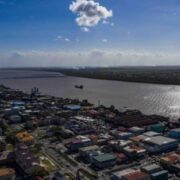TEMPO turns 17 with launch of new streaming platform
For 17 years, TEMPO Networks has produced groundbreaking content showcasing the vibrant energy of the Caribbean through lifestyle programming focusing on the region’s extraordinary destinations, music, cuisine, artistry and culture.
Primarily viewed on cable throughout the Caribbean and in parts of North America, the world will now be able to access all of this free of charge via TEMPO’s new streaming platform, TEMPO+.
Launched in celebration of the Network’s 17th birthday, TEMPO+ will be available on all platforms, including, iPhones, androids, AppleTV, Amazon Fire, Google TV, Roku, etc. TEMPO+ will be loaded with a select mix of TEMPO’s iconic past shows, current shows, and new shows in development, planned for exclusive release on the platform.
“I can hardly contain my excitement, as we prepare the Network for the next leg of this remarkable journey,” said Frederick A. Morton, Jr., Founder, Chairman and CEO, TEMPO Networks.

Frederick Morton, Jr.
“TEMPO’s 17th anniversary and the launch of TEMPO+, together with the very significant content development initiatives planned are bringing back fond memories of when TEMPO launched in 2005, which most will agree was one of the most exciting times in the history or the Caribbean media and entertainment,” said Morton, Jr.
Pitched initially to MTV in 2005 where Morton Jr worked as Senior Vice President, Head of the litigation department, TEMPO found new life in 2007 when he bought back the channel from MTV to build a brand that would display the Caribbean, as it ought to be.
Following the acquisition, Tempo expanded its programming to include more lifestyle content in keeping with the trend of international music channels.
The Network now plans to “raise the tempo”, developing a series of new content with international formats and partnerships and delving more deeply into the culture and lifestyle with documentaries.

One such partnership is with international media Company, Complex Media, with the launch of the Caribbean version of the popular web series the “Hot Ones”, which debuted in 2021 with a production in Trinidad & Tobago featuring the likes of Dancehall Sensation, Prince Swanny and comedic sensation, Ro’dey.
The series, sponsored by the Ministry of Tourism, places talent and celebrities under the heat of consuming hot wings laced with the region’s hottest pepper sauces while being interviewed will be launching its second season from Jamaica in December with an amazing line-up of Jamaican celebs.
The third season is already planned for the United States Virgin Islands, where TEMPO will be announcing a groundbreaking content development plan with the United States Virgin Islands Department of Tourism
Tapping into the diaspora market, TEMPO also launched a docuseries entitled “Caribbean Dream” that tells the stories of notable people of Caribbean descent who have excelled in their professions, taking them back home to their island on a nostalgic journey. Featured thus far are the likes of Yvette Noel Shure, Beyonce’s publicist from Grenada and Neal Farinah, Celebrity hairstylist to, among others, Nikki Minaj, Beyonce, etc, who hails from Trinidad and Tobago.
TEMPO Networks also launched a series called Hip Hop Origins, which puts a spotlight on the impact of the Caribbean on the world’s leading musical genre, exploring its beginnings in Jamaica and nurturing in the Bronx, NY. The region’s talented upcoming rappers are spotlighted as they navigate their role in the continued evolution of the musical genre.

TEMPO Networks holds the Caribbean franchise for Hot Ones
TEMPO Networks holds the Caribbean franchise for Hot Ones
At 17, TEMPO Networks has clearly come of age, maturing into a full-fledged Caribbean lifestyle juggernaut, expanding and spreading its wings deeply into the heart of its mission – elevating Caribbean culture.
After 17 years of covering Carnivals all over the Caribbean, TEMPO has now also entered the Carnival Mas arena, with its successful debut of TEMPO Mas Tobago’s first carnival, recently launched in October. With an amazing costume designed by well-known Costume designer, Anya Elias, TEMPO launched a section in the Carnival Band, Fog Angels, entitled, you guessed it, the “HOT ONES”.
“It is a gift delivered straight from the hands of the Almighty to be at the helm of this brand TEMPO, particularly as we now reach the world with the launch of our streaming platform, TEMPO+. Seventeen years after its birth, I am just as excited, even more, than I was then for the amazing work ahead. Rest assured, we will continue to adjust to the changing times, keeping our core values intact, but always remaining the “Hot One,” said Morton Jr.
To access TEMPO Networks content, check us out on your local cable listings or download TEMPO+



